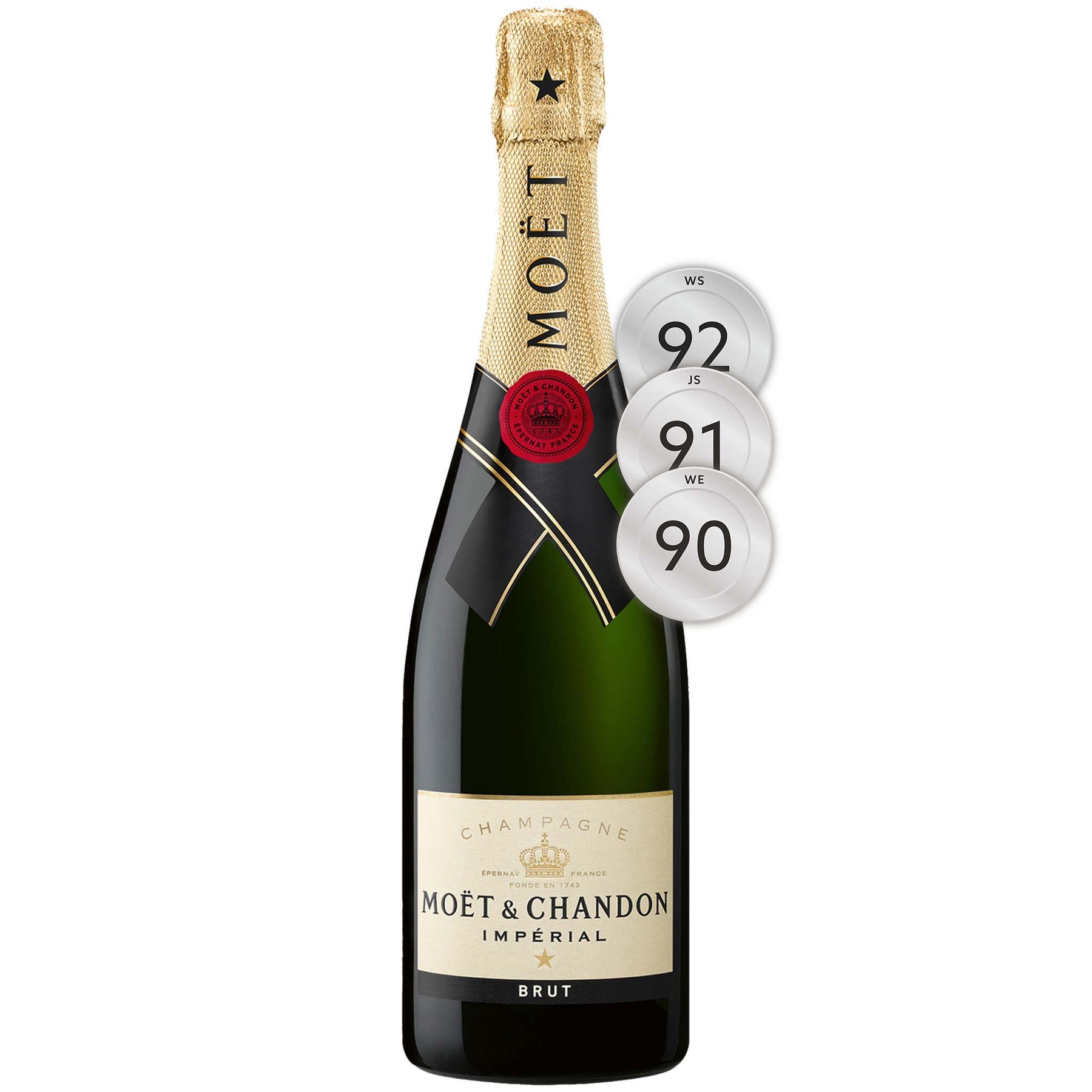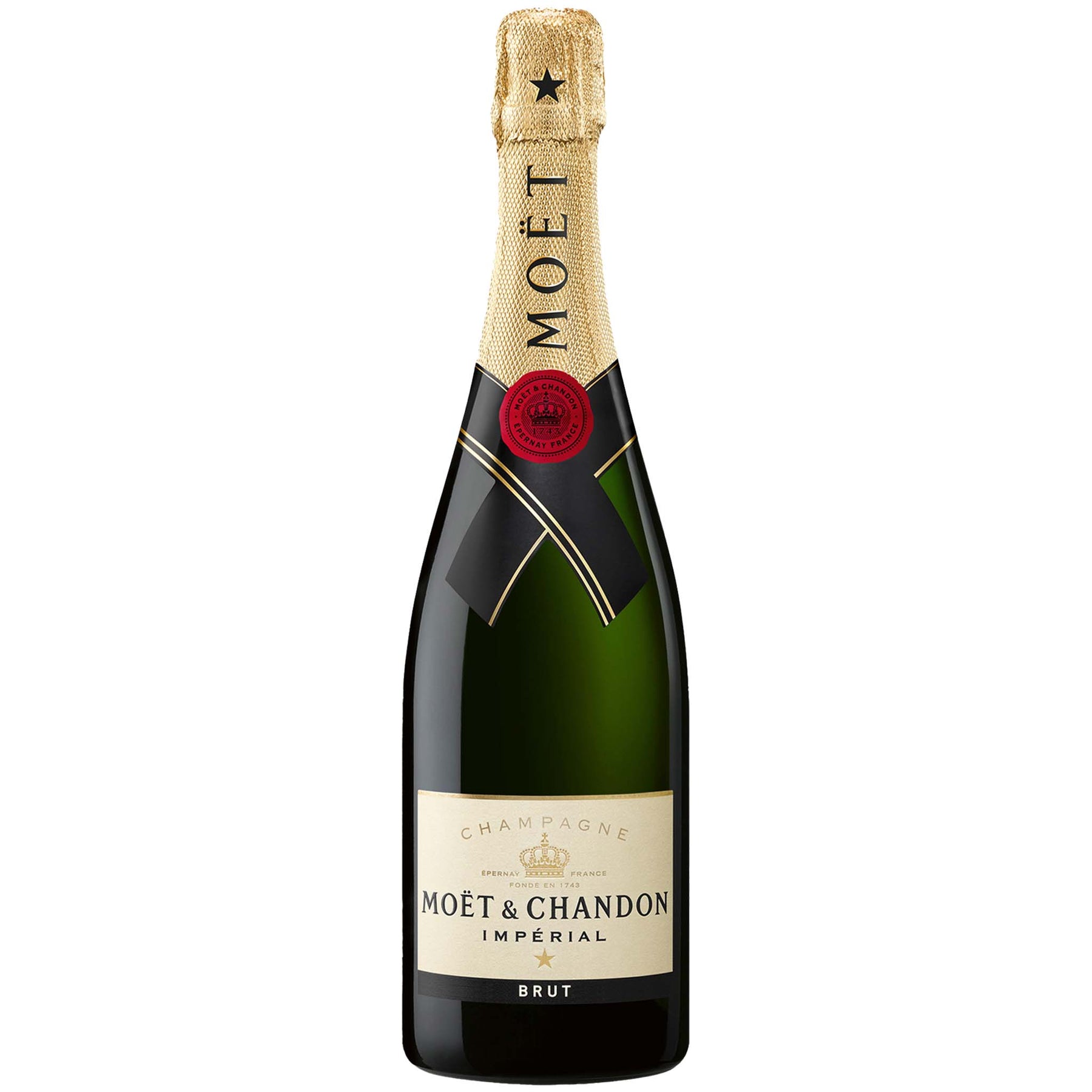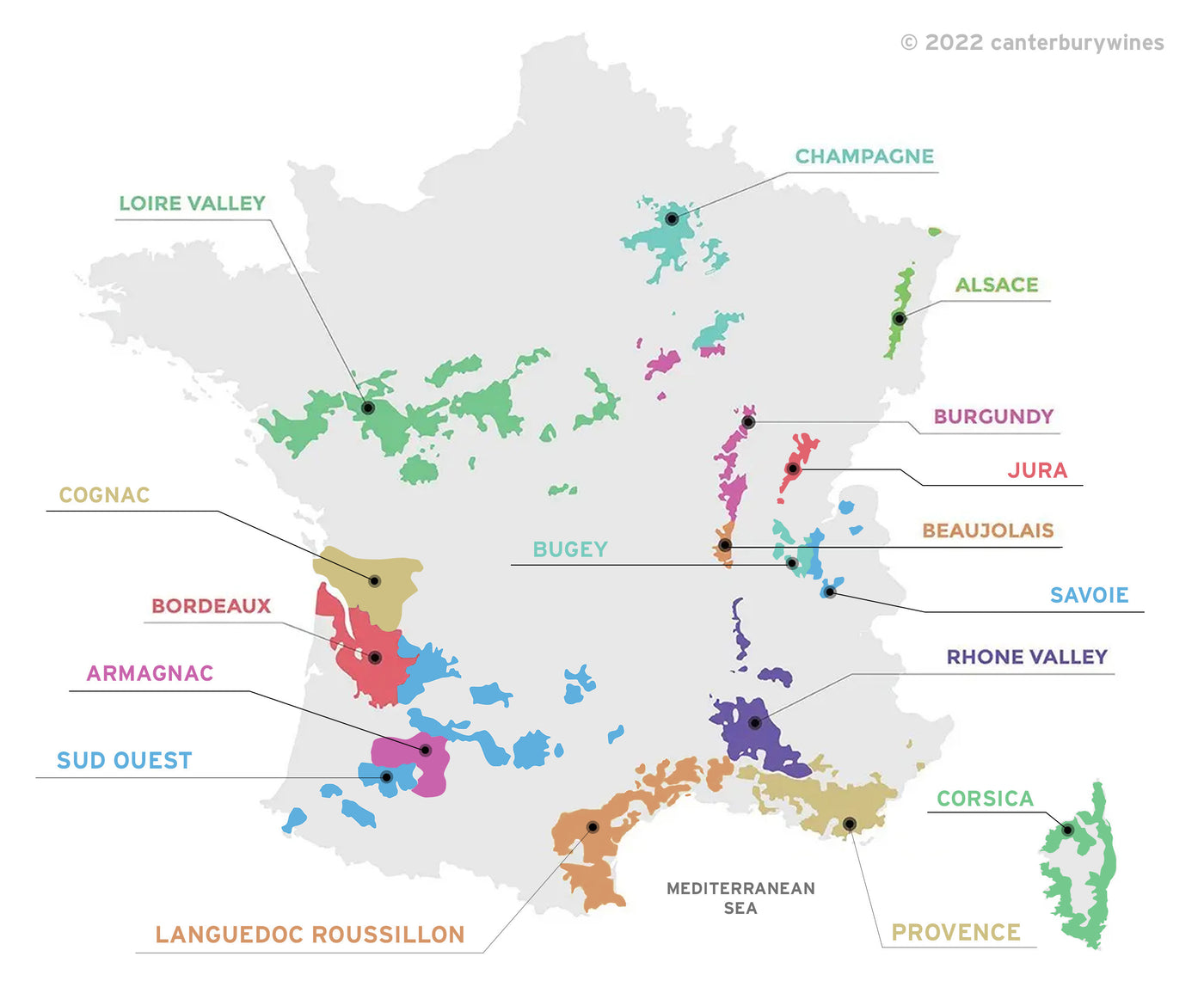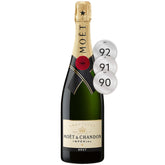

Moët & Chandon Brut Impérial NV
Style: Champagne Brut
Varieties: Pinot Noir (40%), Pinot Meunier (35%), Chardonnay (25%) ≈
Closure: Cork
Moët & Chandon Brut Impérial NV
Warehouse
34 Redland Drive
Vermont VIC 3133
Australia
Critic Score: 92
Alcohol: 12.0% Dosage: 7g/l
Size: 750 ml
Drink by: 2027
Moët & Chandon Brut Impérial was first released in 1869 to celebrate the 100th anniversary of the birth of Napoleon Bonaparte, diminutive lover of bubbly. It is by far the biggest selling Champagne in the world - around 20 million bottles are produced each year, which is about 7% of Champagne’s total production. Brut Impérial is a blend of over 200 crus, of which 20% to 30% are reserve wines. It is an assemblage of Pinot Noir (30 to 40%), Pinot Meunier (30 to 40%) and Chardonnay (20 to 30%). Aged for a minimum of 2 years on lees. The dosage is 7g/l.
"A harmonious Champagne, with well-knit, mouthwatering acidity, offering hints of bread dough and spun honey that enrich flavors of black cherry, salted almond and preserved lemon. Not a powerhouse, but this shows good focus while remaining fine and creamy in texture. The minerally finish shows hints of smoke and oyster shell." Wine Spectator
"Golden straw yellow with green highlights. A sparkling bouquet featuring the vibrant intensity of green apple and citrus fruit, the freshness of mineral nuances and white flowers and the elegance of blond notes (brioche, cereal, fresh nuts). A generous palate combining sumptuousness and subtlety, displaying the delicious sumptuousness of white-fleshed fruits (pear, peach, apple), the alluring caress of fine bubbles and the soft vivacity of citrus fruit and nuances of gooseberry." Moët & Chandon
Expert reviews
"A harmonious Champagne, with well-knit, mouthwatering acidity, offering hints of bread dough and spun honey that enrich flavors of black cherry, salted almond and preserved lemon. Not a powerhouse, but this shows good focus while remaining fine and creamy in texture. The minerally finish shows hints of smoke and oyster shell. Pinot Noir, Pinot Meunier and Chardonnay. Drink now. Tasted 2023." Alison Napjus, Wine Spectator - 92 points
"This is showing aromas of apricots, grapefruit, pears and short crust. Some walnuts, too. Medium-bodied, with soft bubbles and tasty nut and pie crust notes at the end. Blend of pinot noir, meunier and chardonnay. 24 months on the lees. Tasted from a magnum bottle. Drink now. Tasted July 2023." James Suckling, JamesSuckling.com - 91 points
"This Champagne gets better and better. It has a fine dryness with a crisp apple and citrus character. That goes with the touches of maturity that give the wine fine balance. Drink now. Tasted Jan 2023." Roger Voss, Wine Enthusiast – 90 points
Impérial NV

"Moët Imperial is a little bit of everything. That’s the beauty of that wine. There are so many elements involved. Maybe where a Vintage is for a certain special moment, for me Imperial is for every moment. What I like about Imperial is the idea of spontaneity. Not being obliged to wait for a special occasion. Not being obliged to have the right temperature and the right glass, but just 'Let’s have a glass now.' And you know that if you have a glass of Imperial, you’ll be very happy with your glass. It’s the kind of champagne that always seduces and delights, whatever the circumstances.
Each year, we face the awesome challenge of re-creating the Moët & Chandon Impérial with the same recognisable taste that is beloved around the world, despite having to use grapes that, at each harvest, are never the same in aroma or ripeness. To achieve both consistency and quality, we accompany the process of winemaking at every stage, from the blending of still wines made from three grape varieties within months of the harvest, through the careful elaboration and the bottling of the same Champagne style at Moët & Chandon year after year." Benoît Gouez, Chef de Cave
Brut Impérial was first released in 1869 to celebrate the 100th anniversary of the birth of Napoleon Bonaparte, diminutive lover of bubbly and close personal friend of Jean-Rémy Moët, the gregarious vintner and grandson of house founder Claude Moët.
In its day, Impérial was something of a revolution. Less than one percent of champagne produced was labelled 'brut' (and even the brut of 1869 was much sweeter than today’s dry version). But the relative lightness of Brut Impérial - its elegance above all - has endured. Moët Impérial today is nothing short of an icon, its gold foil–wrapped bottle a universal symbol of celebration. It is by far the biggest selling Champagne in the world - around 20 million bottles are produced each year, which is about 7% of Champagne’s total production.
Brut Impérial is a blend of over 200 crus, of which 20% to 30% are reserve wines specially selected to enhance its maturity, complexity and constancy. The assemblage reflects the diversity and complementarity of the three grape varietals used; the full body of Pinot Noir (30 to 40%), the suppleness of Pinot Meunier (30 to 40%) and the finesse of Chardonnay (20 to 30%). The wine is aged for a minimum of 2 years on lees and sits for 6 months after disgorgement before release.
Impérial has become fresher and less sweet over time. When Benoît Gouez arrived in 1998 the dosage was 13g/l. "We trialled it and found we preferred 11g/l," he says, "But we kept 13g/l for customers." The dosage was subsequently reduced to 9g/l and today sits at 7g/l.
The following text is taken from an article by Sam Kessler that appeared in The Oracle Time, April 2017.
Drinking champagne is easy, so much so that I find myself doing so without meaning to on all too many occasions. Making it on the other hand is far, far less so.
Most educated epicureans are well aware that each bottle of champagne is a blend of different wines from different vineyards around the geographical region. Many even know the three main grapes that entails: Pinot Noir, Meunier and Chardonnay. Very few however really appreciate what that means for the winemakers themselves.
In the case of the world’s largest champagne house, Moet & Chandon, head winemaker Benoît Gouez has an unenviable task. We were fortunate enough to have a private tasting with Benoît and… well… we won’t be starting a champagne house any time soon.
For of all are the sheer number of wines that get used at Moet & Chandon. Three different grape varieties yes, but the sheer number of vineyards these come from is staggering. Each vineyard has its own unique terroir, the landscape that gives the grapes their characteristics. This in turn means that, even if each uses the same grapes and same quality of grape, the wines coming from each will be completely different.
Even then, that’s never the case. Champagne has no uniform climate. It’s myriad different landscapes and terroir variances, not to mention weather that makes Britain seem consistent, all mean that every harvest is completely different.
For some wines this wouldn’t be a problem; indeed for some champagnes it’s not. Variance is what makes a vintage a vintage, a snapshot of the region on a given year. But imagine what that means for something like Moet Imperial.
Imperial is the signature of the house, the wine that defines its character to the world at large. In essence it’s the truest expression of what Moet & Chandon is. The key to that is consistency. Each It’s Benoît’s job to ensure that consistency in the face of all adversity. Fortunately for him, champagne has learned over the years that when one grape suffers, another flourishes. Where one year the Chardonnay gets destroyed by late frosts, the Pinot Noir is better than ever.year it must be the same, over and over without fail, regardless of the quality of grapes that year.
The trick that Benoît has mastered is how to balance the good with the bad. The same volume needs to be made after all, and the same elements have to go into it to create that consistent profile of Moet Imperial. Where one component wine is lacking in body, another needs to be positively overweight. Where on lacks acidity, another needs to be razor-sharp.
During the course of the harvest and following winemaking period Benoît will sample hundreds and thousands of wine, equating to about 30 a day. He and his team of tasters will work through everything, pinpointing where each is strongest in order to better understand how they can fit into the Imperial puzzle.
So far so tricky, right? What we’ve yet to factor in however is the reserves. Reserves are the good wines that Benoît keeps each year, holding them back for a particular blend or in case of emergency. These can be a lifeline when the grapes of a particular harvest are lacking, adding some much-needed oomph to the blend.
They are not however something Moet can afford to go overboard with. There’s no guarantee that a wine of that quality will be replenished the next year. If it’s earmarked for a certain blend and there’s not enough to go around, disaster strikes. Reserves may be an invaluable resource, but they add yet another layer of complexity to an already-labyrinthine proposition.
So what’s Benoît’s secret to keeping the consistency of Imperial? Quite simply there isn’t one. There’s no shortcut, no easy solution. Each year is fraught with next-to-impossible decisions, decisions that only experience can account for. Nobody knows Moet like Benoît, neither the profile of their wines nor the contents of their cellars. In short, there’s nobody alive that could do what he – and indeed the Chef de Cave of any champagne maison – can do.
So next time you buy a bottle of Imperial, next time someone questions the quality of a non-vintage over a vintage, just explain to them clearly and eloquently just how much work went into creating that beautifully balanced, invariably consistent bottle of wine. If you can’t… well, we’re probably in the same boat.
Chef de cave

Benoît Gouez joined Moët & Chandon in 1998 as a winemaker and became the Chef de Cave in 2005 at only 35 years old. He's been in this role for 18 years, a mere blip in the House history dating back to 1743. Today he’s responsible for producing around 30 million bottles of champagne annually.
Benoît did not grow up in the Champagne region in northeast France. He was raised in Saint-Lô in neighbouring Normandy, "nowhere near a vineyard." He adds, "I don’t view this as a weakness, but rather as an opportunity, because I don’t have the weight of tradition on my shoulders.
His early interest was in science - he entered college in Montepellier in 1990, at the age of 20, to study agronomy. It was here he met his mentor, Denis Boubals, the professor of viticulture, and switched to viticulture and winemaking.
His professional life began not in France but in the New World world. An internship at a winery in California’s Anderson Valley was followed by stints at wineries in Margaret River in Australia and Cloudy Bay in New Zealand. These experiences made him, "realise that sometimes in France we can be fixated with regulations and the idea of 'vin de terroir', meaning the wine should express the place from where it originates. In the new world, the approach was different. It was more open to technical possibilities."
In 1998, at the age of 28, Benoît arrived in Champagne and was appointed as assistant winemaker at Moët & Chandon. He had been attracted by the combination of technical skill and sensitivity at the Mison, the values of pleasure and sharing wine, and the opportunities to travel. Seven years later he was appointed Chef de Cave.
"I’ve learnt a lot from Richard Geoffroy, the cellar master of Dom Pérignon. He taught me that, beyond technique, it’s the winemaker’s personal sensibility that gives a champagne its soul."
For Benoît, the most challenging aspect of the job is the production of the signature of the house, Moët & Chandon Impérial. "Each year, we face the awesome challenge of re-creating the Moët & Chandon Impérial with the same recognisable taste that is beloved around the world, despite having to use grapes that, at each harvest, are never the same in aroma or ripeness. To achieve both consistency and quality, we accompany the process of winemaking at every stage, from the blending of still wines made from three grape varieties within months of the harvest, through the careful elaboration and the bottling of the same Champagne style at Moët & Chandon year after year."
As for the biggest challenge facing the Champagne industry, he is in no doubt that it is adapting to climate change. "If things continue to evolve as fast as they have in the past 30 years, the discussion of the style of champagne will be pointless; the impact on our lives will be much more important. And second, if you think about what makes champagne unique, it is not in our varieties, or the way we prune, or the way we press, or ferment, or blend, or age. That can be done exactly the same way anywhere in the world. The only thing that makes champagne unique is what is here and nowhere else: the soil and the climate. When you understand that, you start asking what can I do to preserve the local environment? In the past 10 years we have cut by half the use of water. We work a lot on energy. In the vineyards we don’t use insecticides at all. We have a plan to not use herbicides at all within the next three years. Our identity is in our terroir, so we have to respect it, we have to preserve it, we have to even improve it."
About the winery

How to pronounce Moët
The Moët family makes it very clear that the 't' must be pronounced. It’s pronounced 'mo-wet' or 'moe-ette'. The Moët family is originally from the Netherlands and although they moved to France in the 1400s, they still tenaciously hold onto the Dutch pronunciation of their name. Quite brave in a country that would drop the consonant and pronounce the name 'Moe-ay'.
History
Moët & Chandon's history began in 1743 when Claude Moët, a wine merchant in Épernay, founded the Maison Moët. Moët developed over the next few generations as a brand and a business, but it was his grandson Jean-Rémy Moët, who helped create and globalize the Moët identity.
Jean-Rémy Moët was a visionary who built his namesake brand into one of the largest winemakers in the Champagne region. He built the framework for Moët & Chandon’s standing today, including the very chateau housing its headquarters in the heart of Épernay in the Champagne region, and the brand’s vast cellars, which run for some 28 kilometres underneath the city centre and out toward the miles of vineyards. The brand is Jean-Rémy’s legacy.
Jean-Rémy became a close personal friend of Napoleon Bonaparte and their friendship had a huge influence on the fortunes of Moët. The two met in 1782 when Napolean was at military school in Brienne-le-Château and the younger Moët visited the school soliciting orders for the family business. The word 'Champagne' was music to Napoleon’s ears and the two boys became fast friends. After Napolean became Emperor he made a point of visiting the Moët house to stock up on cases of Champagne before every military campaign. Napoleon famously said, "Champagne! In victory one deserves it, in defeat one needs it." After one terrible defeat, the Russian army plundered the cellars of Champagne and Jean-Rémy watched 600,000 bottles of Moët emptied by Russian soldiers camped on the premises. He didn't panic but instead recalled an old French proverb: 'Qui a bu, boira' or 'He who has drunk once will drink again.' Moët told all his friends, "All of those soldiers who are ruining me today will make my fortune tomorrow. I’m letting them drink all they want. They will be hooked for life and become my best salesmen when they go back to their own country." He was right; the Moët business soared in those following years and among the clients clamoring for a taste were some of Napoleon’s famous adversaries, including the First Duke of Wellington and Frederick William III of Prussia.
In 1832, nine years before Jean-Rémy died, his son Victor Moët took over the business and was joined by brother-in-law Pierre-Gabriel Chandon. In 1833, the company was renamed Moët et Chandon.
The concept of vintage champagne or millésimé was introduced in 1840. Two years later in 1842, 99 years after the foundation of the House, Moët marketed its first vintage. The current release Grand Vintage 2015 is the 76th vintage in the history of the House.
Brut Impérial, the House's signature wine, was first released in 1869 to celebrate the 100th anniversary of the birth of Napoleon Bonaparte. Today it is by far the biggest selling Champagne in the world - around 20 million bottles are produced each year, which is about 7% of Champagne’s total production.
In 1921, Moët & Chandon bottled its first ever cuvée de prestige alongside its regular vintage release. In 1937 they purchased the brand name 'Dom Pérignon' and released their 2021 prestige cuvée under that name. Some 15 years ago, Dom Pérignon was 'separated' from Moët & Chandon and branded as a Champagne house in its own right.
Moët & Chandon featured in the first recorded instance of anyone popping open a bottle of champagne and spraying it on others. Dan Turney was handed a jeroboam of the House's champagne in 1967 after he won the 24-hour Le Mans race and immediately proceeded to open the bottle and spray its contents on himself and the crowd, starting the now-timeless tradition.
Moet & Chandon merged with Hennessy Cognac in 1971 and then with luxury fashion brand Louis Vuitton in 1987, to become Louis-Vuitton-Moët-Hennessy (LVMH). LVMH is the world's largest and most successful purveyor of luxury goods, with an €80 billion revenue in 2022.

Vineyards
Moët & Chandon own 1,190 hectares of calcareous vineyards in the Champane region, 50% of which are classified as Grand Cru and 25% as Premier Cru. This makes them the largest vineyard owner in Champagne. However, the grapes from their estate vineyards only supply around 25% of their production needs, forcing them to purchase the balance from growers outside of these lands.
Moët & Chandon source their fruit from all the sub-regions of Champagne, namely Montagne de Reims, Côte des Blancs, Vallée de la Marne, Côte de Sézanne and Côte des Bar. In all, they have access to approximately 200 of the 323 crus in the region, including 100% of the 17 Grand Crus and 70% of the 44 Premiers Crus. This wide-range of vineyards allows the optimum selection of grapes, enabling them to maintain the constancy of Moët Impérial and the originality of Grand Vintage.
The Wines
Brut Impérial NV
Brut Impérial was first released in 1869 to celebrate the 100th anniversary of the birth of Napoleon Bonaparte, diminutive lover of bubbly and close personal friend of Jean-Rémy Moët, grandson of house founder Claude Moët. It is by far the biggest selling Champagne in the world - around 20 million bottles are produced each year, which is about 7% of Champagne’s total production.
Brut Impérial is a blend of over 200 crus, of which 20% to 30% are reserve wines. It is an assemblage of Pinot Noir (30 to 40%), Pinot Meunier (30 to 40%) and Chardonnay (20 to 30%). The dosage is 7g/l. Aged for a minimum of 2 years on lees.
Rosé Impérial NV
Rosé Impérial, first released in 1996, is now the market leader of Rosé in Champagne. It is an assemblage of around 45% Pinot Noir, 35% Pinot Meunier and 10% Chardonnay. Depending on the year, 20% to 30% of the blend are reserve wines specially selected to enhance its intensity, subtlety and constancy.
Grand Vintage
Moët & Chandon marketed its first vintage champagne in 1842. The current release Grand Vintage 2015 is the 76th vintage in the history of the House. Grand Vintage is a blend of the traditional varieties; Pinot Noir, Chardonnay and Pinot Meunier. Vintage wines are selected as the most interesting wines from the harvest, without thinking about house style.
The varietal blend varies year to year depending on vintage conditions as the base wines reflect the best qualities of the year’s harvest. For example, in 1999 Pinot Noir was the dominant varietal (38%), in 2002 Chardonnay (51%), while in in 2003 it was Pinot Meunier (43%).
Dom Pérignon
Dom Pérignon is named after a 17th century Benedictine monk who was Cellar Master at the Abbey of Hautvillers, near the town of Épernay. A vintage Champagne, it is a blend of approximately 50% Pinot Noir and 50% Chardonnay that showcases both the character of the year and the character of Dom Pérignon. It is the top Champagne (prestige cuvée or tête de cuvée) produced by Moët & Chandon and was first released in 1937 with the 1921 vintage. Although owned by Moët & Chandon, Dom Pérignon is now branded as a Champagne house in its own right.* It is aged in the cellars of Moët & Chandon for at least 8 years in bottle on lees before release.
* It is listed here under Dom Pérignon, not Moët & Chandon.

France
There are 16 major French wine regions, each known for their own unique grape varieties, terroir and wines. They are Alsace, Armagnac, Beaujolais, Bordeaux, Bugey, Burgundy, Champagne, Cognac, Corsica, Jura, Languedoc- Roussillon, Loire Valley, Provence, Savoie, South-West and the Rhône Valley.
The largest region is Languedoc- Roussillon, the oldest is Provence, the most influential and famous are Bordeaux, Burgundy, Champagne, Loire Valley and the Rhône Valley.
French wine is labelled by wine region or appellation rather than by grape variety (except in Alsace). In order to guarantee the quality and provenance of French wines, the French government established the Appellation d'origine contrôlée (AOC) system. Under this system the wine label indicates the geographical origin, quality and, generally, the style of a wine. Many regions are home to multiple appellations; for example, the prestigious Bordeaux region in the southwest of France has over 60 growing appellations.

